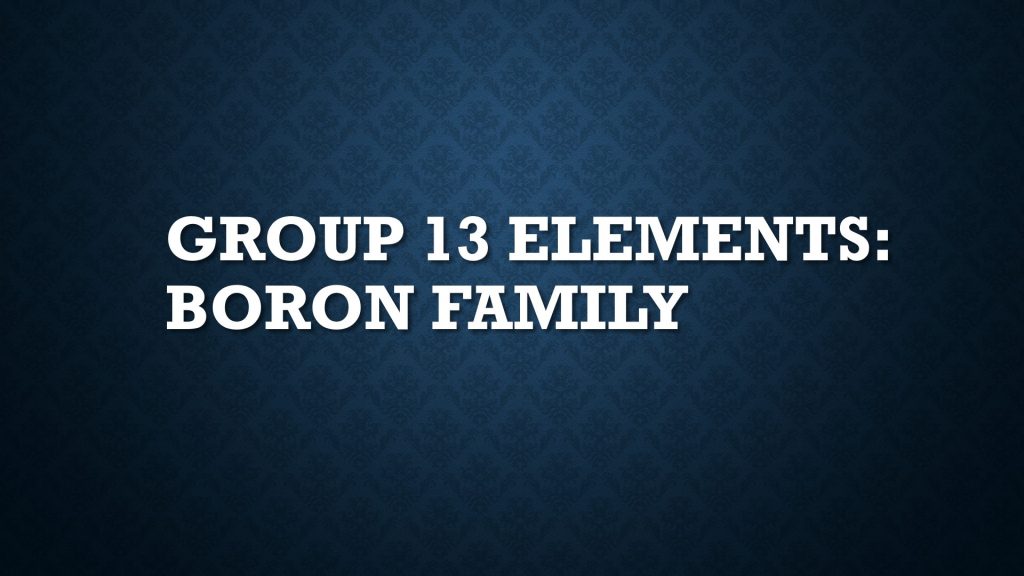Group 13 Elements are the first group of the p-block elements. This group is also called Boron Family. Elements of group 13 are Boron(B), Aluminium(Al), Gallium(Ga), Indium(In), Thallium(Tl), and Nihonium(Nh).

Index
History
Boron was known to ancient Egyptians, in the form of mineral borax. It was not until 1808, that the metalloid was known in its pure form, when Humphry Davy was able to extract it by electrolysis.
Aluminium was first known in minerals before it was finally extracted from alum. Antoine Lavoisier and Humphry Davy had each separately tried to extract it but neither succeeded in doing so. Many attempts followed by various scientists but none succeeded in extracting pure aluminium. The first pure sample of aluminium was found by Henri Etienne Sainte-Claire Deville.
Thallium was discovered by William Crookes and Claude-Auguste Lamy in 1861 when they were examining residues from sulfuric acid production.
Indium is the fourth element of the boron group but was discovered before the third, gallium, and after the fifth, thallium. In 1863 Ferdinand Reich and his assistant, Hieronymous Theodor Richter, were looking in a sample of the mineral zinc blende, also known as sphalerite (ZnS), for the spectroscopic lines of the newly discovered element thallium.
Gallium was first predicted to exist by the creator of periodic table Dmitri Mendeleev, in 1869. In August 1875, French chemist Paul Emile Lecoq de Boisbaudran.
The last element of the boron family, Nihonium was synthesized by the Dubna Joint Institute for Nuclear Research team in Russia, in August 2003. Attempts were made by the Lawrence Livermore National Laboratory in the United States, though it was the Dubna team who successfully conducted the experiment. Nihonium was discovered in the decay chains of moscovium.
The Group 13 Elements or Boron family
The general electronic configuration for the group 13 elements is ns2np1.
| Properties | Boron | Aluminium | Gallium | Indium | Thallium | Nihonium |
| Atomic Symbol | B | Al | Ga | In | Tl | Nh |
| Atomic Number | 5 | 13 | 31 | 49 | 81 | 86 |
| Atomic Mass(amu) | 10.81 | 26.98 | 69.72 | 114.81 | 204.38 | 286 |
| Valence Electronic Configuration | [He]2s22p1 | [Ne]3s23p1 | [Ar]3d104s24p1 | [Kr]4d105s25p1 | [Xe]4f145d106s26p1 | [Rn]5f146d107s27p1(predicted) |
| Atomic Radii(pm) | 90 | 143 | 135 | 167 | 170 | 170 |
| Melting Point/Boiling Point(K) | 2349/4200 | 933.47/2743 | 302.91/2673 | 429.94/2345 | 577/1746 | 700/1430 (predicted) |
| Density(g cm3) | 2.08 | 2.70 | 5.91 | 7.31 | 11.85 | 16 (predicted) |
| First Ionization Energy/kJ mol-1 | 800.6 | 577.5 | 578.8 | 558.3 | 589.4 | 704.9 (predicted) |
| Common Oxidation State(s) | −5, −1, 0 +1, +2, +3 | −2, −1, +1, +2, +3 | −5, −4, −3, −2, −1, +1, +2, +3 | −5, −2, −1, +1, +2, +3 | −5, −2, −1, +1, +2, +3 | (−1), (+1), (+3), (+5) (predicted) |
| Electronegativity | 2.04 | 1.61 | 1.81 | 1.78 | 1.62 | – |
Trends in Group 13 Elements
- Electron Configuration
- The general electronic configuration of group 13 elements is ns2np1. They have 3 electrons in their outermost configuration.
- Atomic Radii
- The atomic radii of the elements in the boron family is seen to increase from boron to Aluminium, decrease from Aluminium to Gallium and then increase again.
- Gallium has a smaller atomic radius than aluminium because the d orbital which is highly diffused offers a poor shielding effect which results in increased nuclear charge. Due to increased charge by the nucleus, outer electrons get attracted, decreasing the radius.
- Ionisation Enthalpy
- The ionisation enthalpy doesn’t have a consistent trend in group 13. Ionisation enthalpy decreases from Boron to Aluminium, increases to Gallium, decreases to Indium and again increases to Thallium. This inconsistency can be attributed to the poor screening effect of d and f orbits of the elements.
- Electronegativity
- Electronegativity also does not have a consistent trend in group 13 due to the same reason stated for ionisation enthalpy.
- Melting and Boiling Points
- The boiling point of group 13 elements decreases from top to bottom consistently due to increase in atomic size. The melting point of group 13 elements does not have a consistent trend.
Applications of Group 13 Elements
- Boron is used in fiberglass, ceramics, and in bleaches in the form of borax.
- Aluminium is used in everyday life. It is used in utensils, construction materials.
- Aluminium is a component of alloys that are used in the making of lightweight bodies for aircraft.
- Gallium has applications in semiconductors, amplifiers, solar cells and in tunnel diodes.
- Gallium is also used in led lighting, in making mirrors, etc.
- Indium is used in solders, heat reflectors, phosphors, nuclear control rods, solar panels, etc.
- Thallium can be found to be used in low-melting glasses, photoelectric cells, switches, etc.
- Thallium is also used in vermin-killers, rat and mouse poisons.
More on P Block
